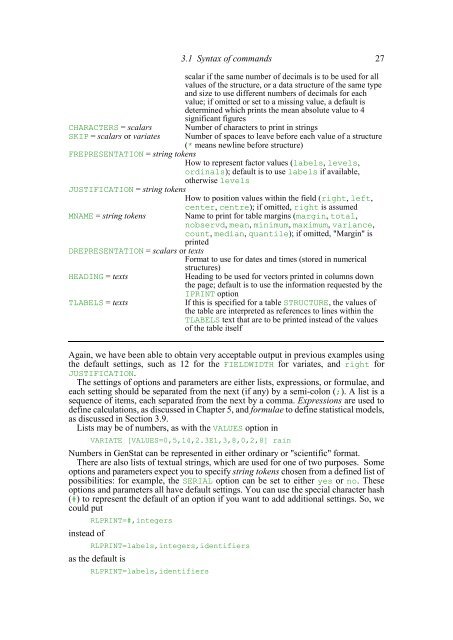Download pdf guide - VSN International
Download pdf guide - VSN International
Download pdf guide - VSN International
- No tags were found...
You also want an ePaper? Increase the reach of your titles
YUMPU automatically turns print PDFs into web optimized ePapers that Google loves.
CHARACTERS = scalarsSKIP = scalars or variates3.1 Syntax of commands 27scalar if the same number of decimals is to be used for allvalues of the structure, or a data structure of the same typeand size to use different numbers of decimals for eachvalue; if omitted or set to a missing value, a default isdetermined which prints the mean absolute value to 4significant figuresNumber of characters to print in stringsNumber of spaces to leave before each value of a structure(* means newline before structure)FREPRESENTATION = string tokensHow to represent factor values (labels, levels,ordinals); default is to use labels if available,otherwise levelsJUSTIFICATION = string tokensHow to position values within the field (right, left,center, centre); if omitted, right is assumedMNAME = string tokensName to print for table margins (margin, total,nobservd, mean, minimum, maximum, variance,count, median, quantile); if omitted, "Margin" isprintedDREPRESENTATION = scalars or textsFormat to use for dates and times (stored in numericalstructures)HEADING = textsTLABELS = textsHeading to be used for vectors printed in columns downthe page; default is to use the information requested by theIPRINT optionIf this is specified for a table STRUCTURE, the values ofthe table are interpreted as references to lines within theTLABELS text that are to be printed instead of the valuesof the table itselfAgain, we have been able to obtain very acceptable output in previous examples usingthe default settings, such as 12 for the FIELDWIDTH for variates, and right forJUSTIFICATION.The settings of options and parameters are either lists, expressions, or formulae, andeach setting should be separated from the next (if any) by a semi-colon (;). A list is asequence of items, each separated from the next by a comma. Expressions are used todefine calculations, as discussed in Chapter 5, and formulae to define statistical models,as discussed in Section 3.9.Lists may be of numbers, as with the VALUES option inVARIATE [VALUES=0,5,14,2.3E1,3,8,0,2,8] rainNumbers in GenStat can be represented in either ordinary or "scientific" format.There are also lists of textual strings, which are used for one of two purposes. Someoptions and parameters expect you to specify string tokens chosen from a defined list ofpossibilities: for example, the SERIAL option can be set to either yes or no. Theseoptions and parameters all have default settings. You can use the special character hash(#) to represent the default of an option if you want to add additional settings. So, wecould putinstead ofRLPRINT=#,integersRLPRINT=labels,integers,identifiersas the default isRLPRINT=labels,identifiers
















